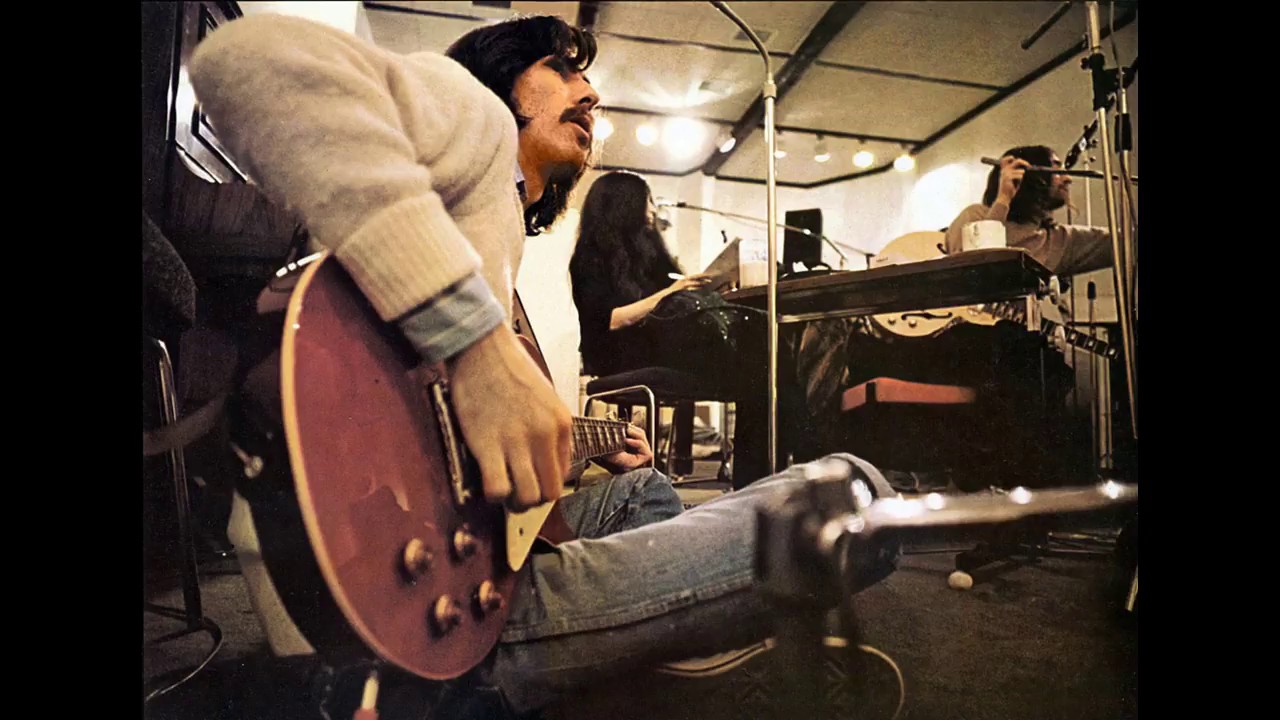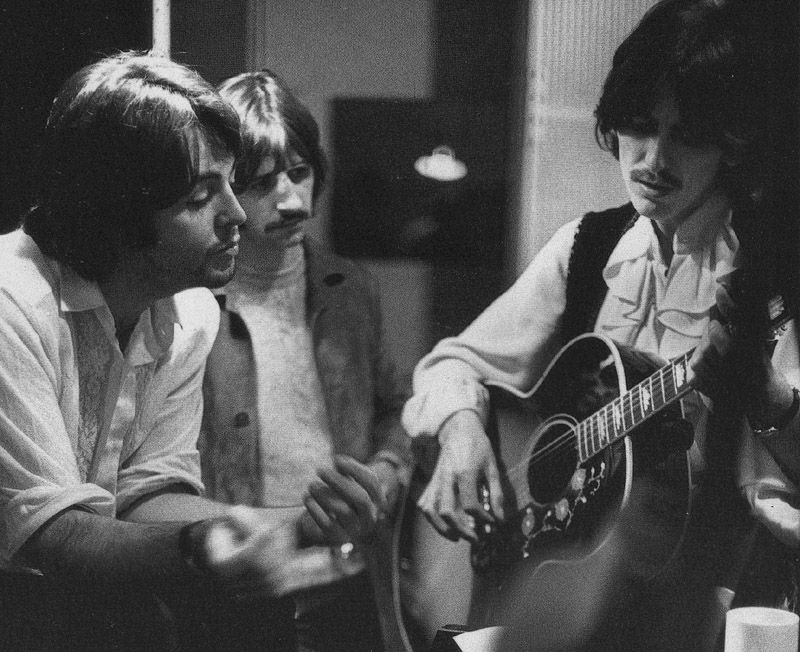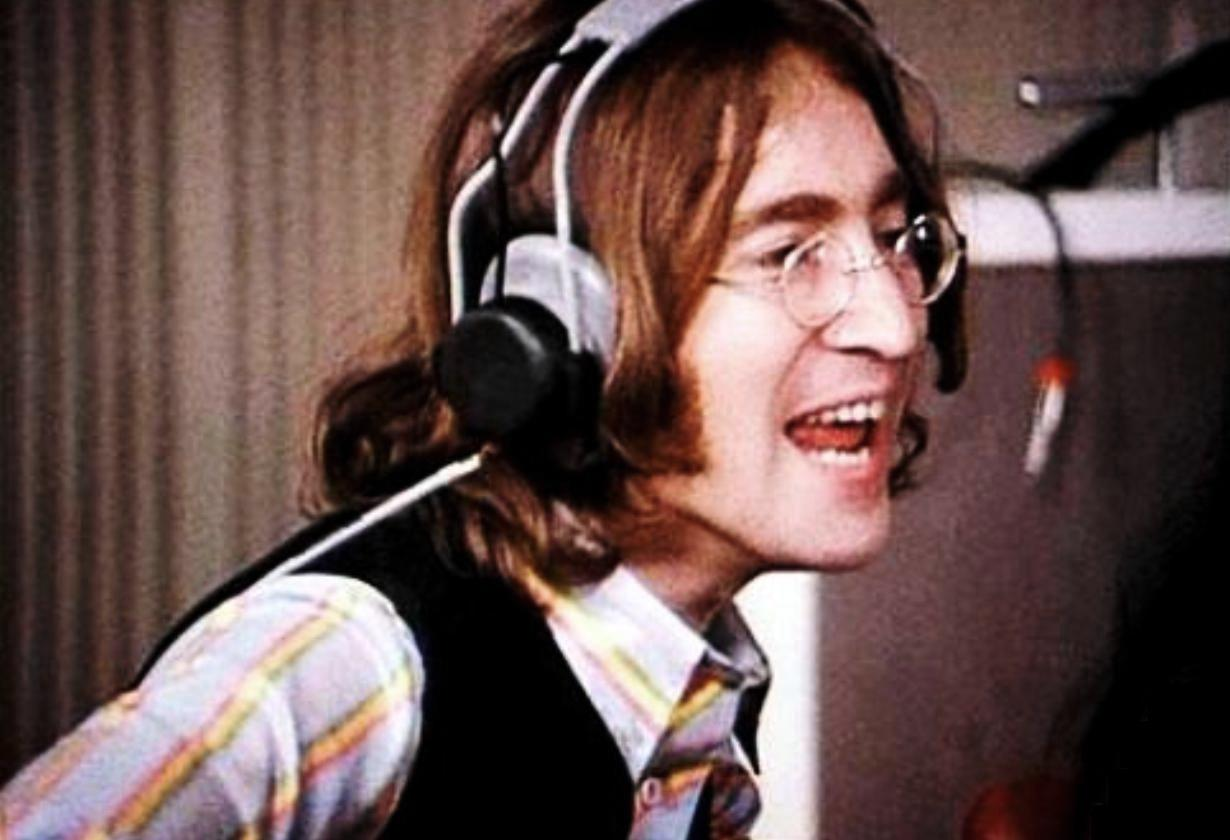The Beatles: Happiness Is a Warm Gun Still Triggers Debate
50 years after The Beatles' White Album was released, "Happiness is a Warm Gun" remains progressive musically and politically.
It is difficult now to hear The Beatles’ song “Happiness is a Warm Gun” without feeling the subliminal twinge of pain associated with John Lennon’s death. Along with the “shoot me” taunts spoken over the introduction of Abbey Road‘s “Come Together,” the anti-gun satire teases strings of predictive allusion. But Lennon wrote the song to bring out a warm and cozy feeling. And no, it wasn’t the first rush of bliss that happens when heroin hits the veins. It was from a book by Peanuts cartoonist Charles M. Schulz which had a panel reading “Happiness is a Warm Puppy.” The intent and the delivery weren’t too far off from what Lennon was pushing with “All You Need Is Love,” and as far as the Beatles were concerned, when it came to violence, you could count them out. And in.
Lennon said the title came from the cover of the May 1968 issue of The American Rifleman the band’s long-time producer George Martin showed him. Lennon told Playboy in 1980 he “took it as the terrible idea of just having shot some animal.” The Beatles weren’t too fond of firearms, in spite of Ringo Starr getting a present of a real pistol from actor Burt Lancaster when they hit Hollywood. The band first landed in the United States only months after President Kennedy was assassinated and were on the record about their concerns of violence, exacerbated by protests, record burnings and firecrackers going off in the middle of concerts. Brian Epstein thought about cancelling the Beatles 1966 tour for fear one of his boys would be taken out by a sniper. Lennon’s “bigger than Jesus” quote brought threats from the Ku Klux Klan.
“There was always that edge in America – we knew they did have guns,” Starr told Rolling Stone. In October 2015, Lennon’s widow Yoko Ono put out ads saying over 1,100,000 people were killed by guns in the United States since her husband was killed on Dec 8, 1980. The CDC confirmed the number, which included suicides and accidental deaths. Lennon’s recording and drinking buddy Harry Nilsson used to give out boozy kisses at Beatlefests for a dollar he would contribute to gun control efforts. “If everyone who had a gun just shot themselves, there wouldn’t be a problem,” George Harrison once quipped.
But you don’t need a gun to blow your mind, and “Happiness Is a Warm Gun” is a mind-blowing song. It is three different songs, actually. Lennon broke the song into three sections, according to an early lyric sheet reprinted in the book Beatles Anthology. The first section is called “Dirty old man.” The middle section is “the junkie.” The third part is “the gunman.” They are set up like movements, rather than the normal verse-chorus-middle-eight structure. The Beatles loved medleys almost as much as melodies, with their recording career culminating in the grand suite closing Abbey Road.
further reading: The Beatles Got Back Where They Belonged in Rooftop Swan Song
Under the ever-vigilant tutelage of manager Brian Epstein, The Beatles were forced to rein in their political and social views while touring and making promotional appearances. Although they did score some Civil Rights points by quietly refusing to play segregated shows, and McCartney was open about being an atheist in the earliest press conferences.
They first broke rank uniformly by coming out against the Vietnam War, and did lob some small jabs at America’s Wild West attitudes towards gunplay. But for the most part they kept their commentary satirical. Harrison attacked the taxman in “Taxman” off the Revolver album. McCartney took on the generation gap in “She’s Leaving Home” from Sgt. Pepper’s Lonely Hearts Club Band. Lennon’s “Ticket to Ride,” off the Help! album, was consciously about self-sufficient women. “You’ve got to Hide Your Love Away,” also off Help!, was a subliminal note of solidarity to his gay manager, Epstein, who would never think of coming out of the closet. Lennon spread the word of love in “The Word,” and offered it as a cure-all in “All You Need Is Love.”
On The White Album, McCartney promotes civil rights with the song “Blackbird,” Harrison takes on the capitalistic leisure class in “Piggies,” and Lennon considers the college protest environment in “Revolution.” Several versions of the song were issued by the band, each one on the precipice of committal. Beyond the title, “Happiness is a Warm Gun” is not a political song, unless it is the politics of sex.

Mother Superior Jumps the Gun
Lennon is often associated with Marx, both Karl and Groucho, but he goes Freudian by giving in to an Oedipus complex by sexualizing the word mother. It appears Lennon found the girl with kaleidoscope eyes he longed for in “Lucy in the Sky With Diamonds.” Yoko is his “Mother Superior,” and she jumped that gun. His relationship with Ono was still new, and he continued to refer to her as “mother” up until his last interviews. Some of the lines came to Lennon during an acid trip with Beatles’ publicist Derek Taylor, the band’s personal assistant Neil Aspinall, who became their de facto manager after Epstein’s death, and original Quarryman Pete Shotten. Lennon denied the song is about using heroin, saying the “I need a fix” line was about his addiction to sex with Yoko. She was, after all, not a girl who misses much.
Lennon sang about “going down” all the way back to “Please, Please Me,” which he said was about oral sex. He would later sing on his Imagine album that when it gets hard, really hard, sometimes he just feels like going down. In concert, when Lennon sang the line about Yoko being “so beautiful I could eat her” in the song “Well, Well, Well,” he would ad lib the line, “and so I did.” The BBC banned “Happiness is a Warm Gun” from airplay in the United Kingdom over the sexually suggestive language.

In His Own Write
Lennon started writing the song while the band was practicing Transcendental Meditation under the giggling tutelage of the Maharishi Mahesh Yogi in Rishikesh, India. He recorded a home demo of the opening with the finger-picking style he learned from Donovan while on the spiritual retreat. He continued adding to it in various stages, from February to September of 1968. Lennon’s original demo was recorded on an Ampex 4-track machine on May 28th, 1968, two days before the band was scheduled to begin recording their next album The Beatles, at Harrison’s “Kinfauns” home in Esher, Surrey. It was basically the Junkie section.
Lennon had been “getting into harder drugs” during the period, McCartney later said, as compiled in Barry Miles’ book Many Years From Now. The band only had made “rather mild, rather oblique references to pot or LSD” in their songs by 1968. Lennon name drops Yoko Ono in the demo, his true addiction, the “Mother Superior” who “jumped the gun.” But she wasn’t cooking his works. Fans and sofa critiques saw the “warm gun” as a needle, but Lennon’s heroin experiments weren’t from injections. He and Yoko “sniffed a little when we were in real pain,” Lennon told Jann Wenner in the 1970 Lennon Remembers interviews. “Cold Turkey,” Lennon’s second solo single, told about his battle with heroin withdrawal. Lines like “need a fix” and “bang, bang, shoot, shoot” are doubly subversive because they draw one naughty conclusion while meaning something else entirely.
further reading: The Beatles’ Magical Mystery Tour Could Have Been a Great Prog Rock Classic
The structure of “Happiness Is A Warm Gun” is unique for The Beatles. “These were all different segments of songs that I wrote altogether and stuck them all in one piece,” Lennon told Rolling Stone. “Just like a collage, instead of an album like Pepper. This was all done in one song and it went through all the different styles of rock ‘n’ roll.” There are no repeated parts. Besides the avant garde experimental sound collage “Revolution 9,” the band doesn’t do anything like this except in the Abbey Road medley. “Happiness Is A Warm Gun” moves through pieces and time signatures. Beats are added to measures to suit the lyrics.
The Beatles started recording the song at 7 p.m. in Studio Two at EMI Studios in London on September 23, 1968. Produced by Chris Thomas because George Martin was on holiday, the basic track is the Beatles’ classic lineup: Lennon on electric rhythm guitar, McCartney on bass guitar, Harrison on lead guitar, with Starr on drums and tambourine. The band recorded 45 takes the first night, and the reels caught them talking about how to approach the complicated time shifts. They finished at 3 the following morning, with nothing usable committed to tape. On September 24th, they ran through 25 takes. Then Thomas and engineers Ken Scott and Mike Sheady spliced take 53 with take 65 for the basic rhythm track.
Over the next two nights, McCartney added another bass guitar, piano, and a tuba track that was mostly pulled out of the mix, though occasionally, the ambient sound of it can be heard. Lennon added an organ part. Ringo overdubbed tambourine and additional snare drum beats. “Happiness Is a Warm Gun” was finished at 5 in the morning of September 26.
The song opens with guitar arpeggios, bass and a single track vocal. The opening phrases have equal lengths. The opening chord is an A-minor seventh, which combines major and relative minor in a single chord. The first three sections establish the relative key of A minor. The first section is in a standard 4/4 time signature. The first part of the song was written last, Derek Taylor said in Steve Turner’s book A Hard Day’s Write. Paul and Ringo appear in the fourth measure playing sixteenth notes on the bass and snare drum to introduce the second section. The fuzz guitar and cymbal slashes hit every other measure in the second part.
Taylor says the line “she’s well acquainted with the touch of the velvet hand” came from something someone said about the sensation of wearing moleskin gloves while being with his girlfriend. The “like a lizard on a window pane” line conjures Los Angeles living, where the band would often see “tiny little lizards nipping up the window.”
“The man in the crowd with multicolored mirrors on his hobnail boots” is about a Manchester City soccer fan who was arrested for putting mirrors on the toe caps of his shoes to look up girls’ skirts at soccer games. Taylor said the “lying with his eyes while his hands were busy working overtime” came from something he’d “read where a man wearing a cloak had fake plastic hands, which he would rest on the counter of a shop while underneath the cloak he was busy lifting things and stuffing them in a bag around his waist.” Taylor didn’t know where the “soap impression of his wife” line came from, but donating to the National Trust was about people crapping “behind bushes and in old air raid shelters.”
The blues waltz phrasing for Harrison’s lead guitar mimics Lennon’s vocal with a mocking sneer. The eleven-measure section two opens in 3/4 time. John drops the arpeggios and plays straight patterns. The lead voice drops low for measures twelve through twenty-one. McCartney sings an octave higher the second half of this part. Paul doubles his bass pattern on the tuba. The line “I need a fix ’cause I’m going down, down to the bits that I’ve left uptown” is repeated twice, with an ascending scale pushing it into the next section. The “mother superior jumped the gun” part of section two runs 18 measures. It is in 3/4 time with every sixth measure played in 4/4. Starr’s tambourine work rivals his drum set work on the song “Rain” in helping the increasingly complicated pattern fit the changing time signatures as the song crescendos into the final part.
The I-vi-IV-V minor iv chord doo-wop chorus has the same chord progression as the song “This Boy.” The first four measures are in 4/4 time, five through ten being in 6/8 time. When Lennon goes into “when I hold you in my arms” the guitars and voices are singing in 6/8 while Ringo keeps a steady four. The harmonies are clipped and choppy into the climax to the song. Lennon sings the last “gun” in a falsetto that runs out the last two measures.

Vocal attacks
The background voices from Lennon, McCartney, and Harrison sometimes mock and are sometimes the lover’s partners. They chide and encourage, provide counterpoint and anticipate phrasings. They set the doo wop harmony rules on shuffle and wash the chords in an abrasive sonic lubricant, sometimes choppy, sometimes sustained. McCartney’s harmonies, along with some done by Lennon straying from the double-tracked lead, are intimate, even when separated by an octave.
The lead vocal is one of the best Lennon recorded with the band. It is truly, as he described it, a history of rock and roll. The very name “rock and roll” was a euphemism for sex and all the sexual innuendo comes through in the voice. His octave jump on the final vocal flourish packs a satiric double punch line for its similarity to the way Lennon and McCartney jumped an octave on the word “hand” in the song “I Wanna Hold Your Hand,” as if they may have wanted to hold something else, but settled for the hand. He uses all his voices in the performance, from the sweet inviting croon of the opening, through the deep insinuations of skin popping and sexual sweat.
Lennon’s performance starts with foreplay. The voice soothing, even though tinged with regret, while the fingers caress the guitar strings like a body. The needle in the arm is penetration and Lennon is a passionate lover. He teeters on the edge of parody in the last section but pulls back by letting it all hang out with masterful timing, projection, and an orgasmic falsetto as satisfied as it is emotionally satisfying.
further reading: The Beatles: Blue Jay Way Is a Hidden Masterpiece
But is the lover Yoko or the gun? The guitar has been called a phallic symbol, but it’s got nothing on a pistol when it comes to squeezing out testosterone. Lennon’s commentary on gun control is that it’s almost masturbatory. There is little scratch control when the finger on the trigger is beyond itchy. Lennon’s psychedelic twist on the horrible feeling he got when thinking about someone shooting animals wasn’t even focused on the human factor, it was about the orgiastic pleasure a hunter gets from taking the life of an animal. Lennon expanded on this idea in the song “Bungalow Bill,” whose antagonistic protagonist justifies tiger hunting because it makes him look fierce. And you have to believe that because his own mother said it about her boy. Yoko plays the mother, a superior woman forever jumping the gun. McCartney would go on to be a lifelong supporter of animal rights, abandoning eating anything with a face and putting his money where his mouth is by enthusiastically endorsing PETA.
The Beatles came out on November 25th, 1968. It was the only double-album of new material The Beatles recorded. There is always some small talk about whether or not it should have been a single album, cutting out what some critics called filler. Many Beatles fans name “The White Album” their favorite specifically because of the eclectic flow. “Happiness Is A Warm Gun” reportedly is McCartney’s and was Harrison’s favorite song on the record. It was the one they had the most fun recording. Its importance is noted in its prominent placement on the album, closing out side one. Lennon’s sonic rock and roll history showed how even moldy oldie chord progressions can be worked as prog with words that subverted the social flow.
There are precognitive moments in the early careers of the Beatles which still shock. A scene in the film Help! shows Victor Spinetti’s mad scientist aim a gun at Lennon and actually pull the trigger. Private Gripweed’s last scene in Richard Lester’s anti-war satire How I Won the War has the wounded soldier, played by Lennon, look defiantly at the camera and admit he knew how he would go out. The collateral damage of “Happiness Is A Warm Gun” is the impact it had on serious musicians and casual listeners alike. It doesn’t call attention to its complexities, yet continues to confound.
Culture Editor Tony Sokol cut his teeth on the wire services and also wrote and produced New York City’s Vampyr Theatre and the rock opera AssassiNation: We Killed JFK. Read more of his work here or find him on Twitter @tsokol.
